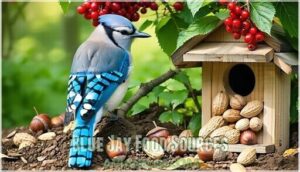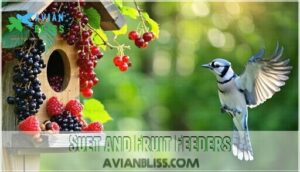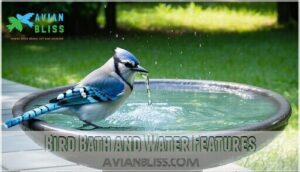This site is supported by our readers. We may earn a commission, at no cost to you, if you purchase through links.
 You’ll discover that blue jays are nature’s opportunists, eating almost anything they can find.
You’ll discover that blue jays are nature’s opportunists, eating almost anything they can find.
They’re also skilled hunters, catching insects, caterpillars, and small frogs to feed their families. Don’t be surprised if you catch them raiding other birds’ nests for eggs—it’s just part of their survival strategy.
These intelligent birds munch on acorns, sunflower seeds, peanuts, and various nuts, which make up about 75% of their diet. Blue jays store thousands of acorns each fall, creating their own winter pantry.
Their eating habits change dramatically with the seasons, and understanding these patterns can transform your backyard into a blue jay paradise.
Table Of Contents
- Key Takeaways
- Blue Jay Diet Overview
- What Do Blue Jays Eat
- Seasonal Diet Variations
- Blue Jay Feeding Habits
- Blue Jay Food Sources
- Baby Blue Jay Diet
- Attracting Blue Jays
- Blue Jay Foraging Behavior
- Blue Jay Dietary Flexibility
- Blue Jay Ecological Role
- Frequently Asked Questions (FAQs)
- Can humans eat Blue Jays?
- How does the Blue Jay store food for future use?
- Can blue jays eat corn?
- What seeds do blue jays eat?
- What is a blue jay’s favorite food?
- Is it good to have blue jays in your yard?
- Do blue jays recognize humans?
- What food to put out for blue jays?
- How do blue jays protect their food stash?
- Can blue jays be trained as pets?
- Conclusion
Key Takeaways
- You’ll find blue jays are true omnivores with 75% of their diet consisting of plant matter like acorns, sunflower seeds, and berries, while the remaining 25% includes insects, small animals, and occasionally bird eggs.
- You can attract these intelligent birds to your yard by offering their favorite foods – whole peanuts, black oil sunflower seeds, and suet blocks – on sturdy platform feeders positioned near trees for safety.
- You’ll notice their eating habits change dramatically with seasons, shifting from cached acorns and nuts in winter to increased insect hunting during summer breeding season when they need extra protein for their chicks.
- You’re watching nature’s ecosystem engineers at work when blue jays cache thousands of acorns and seeds, creating new forests while controlling pest populations by consuming harmful insects like caterpillars and beetles.
Blue Jay Diet Overview
You’ll discover that blue jays are smart omnivores who consume roughly 75% plant matter, including nuts, seeds, berries, and fruits.
They adjust their diet based on seasonal availability, making them successful opportunistic feeders who can thrive in various habitats from forests to suburban backyards, while the remaining 25% consists of insects, small animals, and occasionally bird eggs.
Omnivorous Diet Composition
Blue jays are true omnivores, balancing their nutritional needs with remarkable dietary flexibility.
Their blue jay diet consists of approximately 75% plant matter versus 25% animal sources, creating perfect dietary balance for survival.
You’ll find these intelligent birds consuming everything from acorns and berries to insects and small creatures, showcasing impressive food variety that meets their complex nutritional requirements year-round, demonstrating their ability to thrive with dietary flexibility.
Vegetable Matter Consumption
Plant matter forms the backbone of the blue jay diet, accounting for roughly 75% of their yearly intake.
You’ll find these clever birds cracking open acorns with impressive skill—acorn importance can’t be overstated in their survival.
Seed variety includes sunflower seeds, hickory nuts, and corn kernels.
Berry benefits provide essential vitamins, while fruit selection ranges from wild cherries to elderberries.
Grain consumption supplements their vegetable matter needs perfectly, highlighting the berry benefits and importance of a varied diet with acorn intake.
Animal Matter Intake
While plants dominate their menu, you’ll find these clever birds aren’t picky about protein sources.
Insect consumption includes caterpillars, beetles, and arthropods they snatch from bark and leaves.
Blue jay insects provide essential nutrients, especially larvae during breeding season.
They’ll also grab small animals like frogs, occasionally practice egg predation, and scavenge carrion when available—nature’s opportunistic cleanup crew.
To attract these birds, consider offering sturdy feeders with perches designed for their size.
What Do Blue Jays Eat
Understanding what jays eat reveals fascinating blue jay diet facts that showcase their remarkable adaptability.
These intelligent birds demonstrate flexible blue jay eating habits that range from dietary extremes – consuming everything from tiny insects to small frogs.
Their nutritional needs drive sophisticated food caching behaviors, storing thousands of items for leaner times.
As omnivorous birds, they consume both plant and animal matter.
Here’s what makes up their diverse blue jay food preferences:
- Nuts and seeds – Acorns, sunflower seeds, and peanuts (their blue jay favorite food)
- Insects and protein – Beetles, caterpillars, and small invertebrates
- Fruits and berries – Natural and cultivated varieties
- Opportunistic items – Eggs, small animals, and carrion during food scarcity
Regional variations influence their menu substantially.
Seasonal Diet Variations
You’ll notice blue jays shift their eating habits throughout the year, adapting their diet to match what’s available in each season.
During winter, they rely heavily on cached acorns and nuts, while summer brings increased insect hunting and fall triggers intensive foraging to prepare for colder months, which involves intensive foraging.
Winter Diet Adaptations
Winter transforms blue jays into savvy survivalists who rely heavily on their cached treasures.
Their winter diet shifts to approximately 75% plant matter, with acorns serving as their primary fuel source.
You’ll notice increased carrion consumption and scavenging of human leftovers during harsh months.
Seeds, nuts, and winter berries supplement their menu, while larvae intake provides essential protein.
Urban blue jays may also consume supplementary foods provided by humans.
Fall Diet Changes
Autumn transforms blue jays into nature’s strategic stockpilers.
You’ll notice their feeding behavior shifts dramatically as they prepare for winter’s challenges.
Their insect foraging intensifies while acorn consumption becomes their primary focus, creating fascinating dietary patterns.
- Increased larvae intake provides essential protein before winter scarcity arrives
- Strategic seed storage guarantees survival during harsh months ahead
- Enhanced acorn consumption becomes their main nutritional priority
- Fall berries supplement their energy-rich preparation diet
Summer Diet Preferences
Summer brings insect abundance and berry variety that transforms blue jay foraging behavior.
These clever birds expand their prey selection to include caterpillars, beetles, and arthropods while enjoying wild strawberries and elderberries.
Their nestling diet requires extra protein, making summer the perfect season for diverse feeding.
| Food Category | Examples | Nutritional Benefit |
|---|---|---|
| Insects | Caterpillars, beetles, grasshoppers | High protein for breeding |
| Berries | Strawberries, elderberries, mulberries | Energy and vitamins |
| Arthropods | Spiders, ants, flying insects | Essential amino acids |
Blue Jay Feeding Habits
You’ll notice blue jays display remarkably adaptable feeding behaviors that change based on food availability and seasonal needs.
These intelligent birds use their strong beaks to crack open nuts and seeds, store food in expandable throat pouches, and employ different foraging techniques from aerial insect hunting to ground-level scavenging, which showcases their adaptable nature and ability to use strong beaks.
Seed and Suet Preferences
Dedication to specific seeds and suet makes blue jays incredibly selective feeders.
They’ll crack sunflower seeds with surgical precision, preferring larger varieties that offer maximum nutritional payoff. Suet’s high-fat content provides essential winter energy.
Many bird enthusiasts purchase black oil seeds for their feeders.
Your feeder choices directly impact their visits:
- Black oil sunflower seeds – their absolute favorite
- Peanut-flavored suet – irresistible winter fuel
- Platform feeders – accommodate their size perfectly
- Whole peanuts – trigger their natural caching instincts
Insect Foraging Techniques
Blue jays excel at aerial hunting, snatching fast-moving insects mid-flight with impressive precision.
Their ground foraging techniques involve methodically searching forest floors for beetles, larvae, and arthropods.
During seasonal insects peaks, you’ll observe them hammering bark to extract hidden larvae, and their beetle preference drives systematic hunting behavior, as they flip leaves and probe crevices.
This diverse foraging strategy guarantees consistent protein intake year-round.
Fruit and Berry Consumption
You’ll find that blue jays have a genuine sweet tooth regarding seasonal fruit consumption.
These intelligent birds actively seek out various berries throughout warmer months, with berry nutritional value playing a vital role in their overall health and energy levels.
- Blueberries and blackberries – Prime choices for blue jay nutrition
- Strawberries and raspberries – Preferred fruit types during peak season
- Elderberries and mulberries – Important for seasonal berry changes
- Cherry and grape varieties – Berry size selection influences consumption
- Wild and cultivated options – Fruit availability determines foraging patterns
Blue Jay Food Sources
You’ll find blue jays accessing food from three main sources: natural environments where they forage for acorns, insects, and berries, backyard bird feeders stocked with peanuts and sunflower seeds, and human-provided foods like corn and suet.
These intelligent birds adapt their feeding strategies based on what’s available, making them successful in both wild habitats and suburban neighborhoods, which is a key factor in their ability to thrive in various environments with different types of food, such as backyard bird feeders.
Natural Food Sources
While you can easily stock feeders, blue jays naturally thrive on nature’s buffet.
These resourceful birds tap into abundant forest treasures that sustain them year-round.
| Food Type | Examples |
|---|---|
| Acorn Abundance | Oak acorns, beechnuts, hickory nuts |
| Wild Berries | Elderberries, wild cherries, sumac |
| Natural Seeds | Pine seeds, maple keys, grass seeds |
| Forest Insects | Caterpillars, beetles, grasshoppers |
| Carrion Consumption | Small deceased animals, roadkill |
Bird Feeder Preferences
When setting up bird feeders for blue jays, you’ll want sturdy platform or hopper-style feeders that can handle their size and weight.
These intelligent birds prefer open feeding areas over hanging feeders.
Strategic feeder placement near trees provides escape routes from predators.
You can find a variety of specialized blue jay feeders offering varied seed types like sunflower seeds and peanuts in quality feeders guarantees consistent visits from these striking corvids.
Human Provided Foods
Beyond regular bird feeder options, you can offer blue jays human-provided foods that mirror their natural diet.
These intelligent birds quickly learn to associate your yard with reliable food sources.
Popular human-provided options include:
- Whole peanuts – Their absolute favorite treat, mimicking wild nuts
- Cracked corn – Easy to digest alternative to seeds
- Suet blocks – High-energy fat source for winter months
- Fresh berries – Seasonal treats like blueberries and strawberries
Baby Blue Jay Diet
When you’re watching baby blue jays in your backyard, you’ll notice their parents work tirelessly to provide a carefully balanced diet of soft insects, partially regurgitated seeds, and small berries that meet their growing nutritional needs.
These dedicated parent birds adjust their feeding strategy by breaking down harder foods like nuts and seeds before delivery, while offering softer items like caterpillars and small fruits directly to their hungry chicks, which includes providing partially regurgitated seeds and ensuring the chicks receive the right amount of small berries.
Parental Food Provision
During those vital first six weeks, both blue jay parents work around the clock to feed their helpless nestlings.
They’ll regurgitate soft food directly into their chicks’ mouths, delivering pre-digested insects, larvae, and seeds multiple times per hour.
This feeding frequency guarantees rapid growth, with parents carefully selecting the softest chick food types for easy digestion, ensuring the young develop quickly and healthily with pre-digested nutrients.
Insect and Fruit Intake
As parents gather food, baby blue jays receive a carefully balanced mix of protein-rich insects and seasonal fruits. This dietary balance guarantees proper growth during their most vulnerable weeks.
The insect nutrition these chicks receive includes:
- Soft-bodied arthropods like caterpillars and grubs
- Fresh berries when fruit availability peaks
- Beetles and crickets for essential amino acids
Smart foraging strategies help parents locate seasonal abundance.
Seed and Grain Consumption
Introducing seeds and grains happens gradually as baby blue jays mature.
You’ll notice parents bringing sunflower seeds, cracked corn, and small nuts to the nest. These foods provide essential carbohydrates and fats for rapid growth.
Parents demonstrate proper caching behavior, teaching chicks to store food for later. The nutritional value of these grain types supports feather development and energy needs, which is crucial for the young birds’ survival and rapid growth.
Attracting Blue Jays
You’ll find success attracting blue jays to your yard by offering their favorite foods like whole peanuts, sunflower seeds, and suet in sturdy platform feeders that can support their weight.
These intelligent birds also need fresh water sources and nearby trees or shrubs for perching, so combining the right food with proper habitat features creates an irresistible invitation for these striking visitors.
The combination of the right food and proper habitat is crucial, as it allows blue jays to thrive, and nearby trees or shrubs provide them with the necessary perching areas.
Peanut and Sunflower Seed Offerings
Peanuts are blue jay magnets—they’ve got "peanut radar" and’ll appear instantly when you offer them.
Choose in-shell or shelled varieties for variety.
Black-oil sunflower seeds work best as bird food, though striped varieties attract them too.
Position feeders on sturdy poles rather than hanging them, since blue jays prefer stable platforms.
Install squirrel baffles to protect your bird feeding investment.
Suet and Fruit Feeders
Suet types like plain, nut-embedded, and berry-blended varieties provide essential fats that blue jays crave year-round.
Your blue jay bird feeder should offer fresh berries—elderberries, blackberries, and chopped apples work wonderfully. Consider purchasing specialized blue jay blends for superior nutrition.
Strategic feeder placement and squirrel protection guarantee these intelligent birds access their favorites without competition.
Best food for jays includes:
- High-fat suet blocks with embedded nuts
- Fresh blue jay berries like elderberries and raspberries
- Chopped fruits on platform bird feeders
Bird Bath and Water Features
Beyond bird food, water draws Blue Jays like magnets.
They need fresh water for drinking and bathing behavior observed throughout seasons.
Install heated bird baths for winter water solutions, ensuring water source hygiene through regular cleaning.
Position baths in open areas where these intelligent birds feel safe while attracting birds to your yard consistently.
| Bird Bath Feature | Blue Jay Benefit |
|---|---|
| Heated water source | Year-round hydration access |
| Open positioning | Clear predator visibility |
| Shallow depth (1-2 inches) | Safe bathing and drinking |
| Regular cleaning schedule | Prevents disease transmission |
| Solar-heated options | Natural winter water solutions |
Blue Jay Foraging Behavior
You’ll notice blue jays employ three distinct foraging strategies: they hunt insects mid-flight with impressive aerial acrobatics, methodically search the ground for hidden worms and beetles, and cleverly cache thousands of nuts in secret locations they’ll remember months later.
These intelligent birds switch between hunting techniques based on the season and available food sources, making them incredibly adaptable survivors in various habitats, utilizing aerial acrobatics and cleverly caching nuts for survival, which showcases their intelligent nature.
Aerial Hunting Techniques
Blue jays transform into skilled aerial hunters when pursuing flying insects.
You’ll watch them execute precise flight maneuvers, diving and swooping to catch beetles, flies, and moths mid-air.
Their capture strategies involve quick directional changes and split-second timing.
During summer months, this hunting seasonality peaks as insect populations surge, making blue jays remarkably effective bird foraging specialists through strategic prey selection.
Ground Foraging Methods
When foraging on terra firma, blue jays transform into methodical ground detectives.
They’ll systematically search through leaf litter, probe soil with their beaks, and detect insects with remarkable precision.
You’ll often spot them extracting worms or consuming carrion they’ve discovered.
Their fondness for acorns and nuts can be supported by planting nut-bearing trees.
- Leaf Litter Search – Tossing aside fallen leaves to uncover hidden beetles and larvae
- Soil Probing – Using their sturdy beaks to dig for earthworms and grubs
- Insect Detection – Spotting movement of ants, caterpillars, and other ground-dwelling prey
- Carrion Consumption – Scavenging protein-rich remains when nuts, seeds, and acorns are scarce
Cache and Retrieval Strategies
Like squirrels with photographic memories, Blue Jays excel at caching thousands of acorns and nuts using sophisticated cognitive maps.
Like nature’s master architects, Blue Jays design tomorrow’s forests one strategically buried acorn at a time.
Their retrieval accuracy reaches 80% even months later, thanks to detailed mental notes about storage locations.
However, pilfering behavior from other jays means they’ll often watch and steal cached food.
This caching frequency peaks during fall foraging when winter survival depends on their hidden treasures.
Blue Jay Dietary Flexibility
You’ll find that blue jays adapt their eating habits with remarkable flexibility, switching between 75% plant matter in winter to higher insect consumption during breeding season based on what’s available in their environment.
These opportunistic feeders can thrive across different regions and seasons because they’ll adjust their diet from acorns and nuts to berries, insects, and even human food scraps when natural sources become scarce, allowing them to be opportunistic feeders and consume a variety of food including insects.
Adaptation to Available Food Sources
Remarkably adaptable omnivores, Blue Jays demonstrate impressive dietary plasticity when facing food scarcity or habitat changes.
Their bird adaptability shines through urban adaptation, where they’ve learned to exploit new food sources beyond traditional acorns.
Climate influence drives these behavioral shifts, making habitat foraging incredibly flexible.
- Urban environments – exploit garbage, pet food, and human-provided resources
- Forest fragmentation – switch between multiple smaller food patches efficiently
- Seasonal shortages – increase scavenging and opportunistic feeding behaviors
Seasonal Diet Adjustments
You’ll notice blue jays shift their diet dramatically throughout the year.
Winter food scarcity drives them toward cached acorns and seeds, while spring nesting diets include protein-rich insects for growing chicks.
Summer berry abundance provides easy nutrition, and fall insect foraging helps them build fat reserves.
These seasonal changes showcase their remarkable adaptability to nature’s rhythms, with a focus on protein-rich insects and the need to build fat reserves.
Geographic Diet Variations
Blue jays across North America adapt their diet based on regional food sources and habitat diet influence.
You’ll notice climate diet impact shapes their preferences – northern jays rely heavily on acorns and cached nuts, while southern populations enjoy more insects year-round.
Local plant variations mean coastal blue jays access different berries than mountain dwellers, with prey availability dictating protein sources.
Despite common misconceptions, nest predation is rare, which highlights the importance of understanding regional food sources and habitat diet influence.
Blue Jay Ecological Role
When you observe blue jays in your backyard, you’re watching nature’s own ecosystem engineers at work, as these intelligent birds play vital roles in forest regeneration and pest control.
Their habit of caching thousands of acorns and seeds creates new woodlands, while their appetite for insects helps maintain the delicate balance that keeps your local environment healthy, making them a key part of forest regeneration and pest control.
Seed Dispersal and Forest Renewal
When you watch blue jays stuffing acorns into their throat pouches, you’re witnessing nature’s gardeners at work.
Through caching behaviors, these birds bury thousands of seeds across forests. Forgotten Seeds become tomorrow’s oak trees, creating Forest Expansion that benefits entire ecosystems.
Their Ecosystem Impact extends far beyond feeding—each cached acorn represents potential forest renewal and habitat creation, illustrating the significant role of these birds in shaping their environment through caching behaviors.
Insect Population Control
Beyond scattering seeds, you’ll find blue jays act as natural pest controllers in your yard.
Their beneficial predation targets harmful insects like caterpillars, larvae, and worms that damage plants.
This foraging impact creates ecosystem balance by reducing pest populations naturally.
Through larvae consumption and hunting various blue jay prey, these birds protect your garden while maintaining environmental harmony without chemical interventions.
Ecosystem Engineering and Biodiversity Support
Through their relentless caching of acorns and seeds, Blue Jays serve as nature’s gardeners, planting forests one buried treasure at a time.
Their forgotten stashes become tomorrow’s oak groves, creating essential habitat for countless species.
You’ll witness firsthand how their seed dispersal drives forest renewal and expansion, while their insect control maintains ecological balance, supporting biodiversity across entire ecosystems.
Frequently Asked Questions (FAQs)
Can humans eat Blue Jays?
Historically, about 300 bird species have been consumed by humans worldwide.
They’re protected under federal law, carry diseases, taste poor, and aren’t raised for consumption like poultry.
How does the Blue Jay store food for future use?
Blue jays use their expandable throat pouch to temporarily store multiple nuts and seeds.
They’ll cache these treasures by burying them in soil, creating scattered pantries they’ll return to during leaner times.
Can blue jays eat corn?
Yes, you’ll find that blue jays absolutely love corn.
They enthusiastically consume cracked corn, whole kernels, and even corn directly from the cob, making it an excellent choice for attracting these intelligent birds.
What seeds do blue jays eat?
You’ll find blue jays enthusiastically devouring sunflower seeds, both black and striped varieties, plus acorns, hazelnuts, and hickory nuts.
They’ll also crack open peanuts and munch on cracked corn kernels at your feeders.
What is a blue jay’s favorite food?
Peanuts reign supreme as a blue jay’s favorite food.
You’ll witness their "peanut radar" in action when they quickly appear at feeders offering whole, unsalted peanuts in shells, which they expertly crack open.
Is it good to have blue jays in your yard?
Having blue jays is like winning nature’s lottery – they’re excellent pest controllers, devouring thousands of harmful insects while warning other birds about predators.
You’ll enjoy their intelligence and vibrant presence year-round.
Do blue jays recognize humans?
These intelligent corvids can distinguish between individual faces and remember who’s friendly or threatening.
They’ll learn your routine, recognize your voice, and may even approach you regularly if you consistently provide food.
They’ll also remember who’s friendly or threatening based on past interactions.
What food to put out for blue jays?
Offer whole peanuts, sunflower seeds, cracked corn, and suet on platform feeders.
You’ll attract these intelligent birds by providing their favorites – they’ll quickly learn your feeding schedule and return regularly.
How do blue jays protect their food stash?
Like master thieves hiding their treasure, blue jays don’t actually guard their cached nuts and seeds.
Instead, they’re sneaky about burial locations, often storing food when you’re not watching and remembering hundreds of hiding spots, which makes them very efficient at retrieving their cached food.
Can blue jays be trained as pets?
You can’t legally keep blue jays as pets in North America.
They’re protected by federal law, requiring special permits for wildlife rehabilitation.
These intelligent, social birds need wild habitats to thrive properly.
Conclusion
Like master chess players contemplating their next move, blue jays demonstrate remarkable strategic thinking when selecting their meals.
Understanding what do blue jays eat reveals their incredible adaptability and intelligence in the natural world.
You’ve learned that these opportunistic birds thrive on diverse diets ranging from acorns to insects, adjusting their preferences seasonally.
By providing peanuts, sunflower seeds, and fresh water in your yard, you’ll create an inviting habitat that supports these fascinating corvids year-round, and understand their incredible adaptability.
- https://www.bhg.com/gardening/design/nature-lovers/suet-for-birds/
- https://www.timesobserver.com/sports/outdoor/2022/10/blue-jays-eat-and-store-acorns-helping-to-spread-oak-trees/
- https://kennedywildbirdfood.co.uk/blog/how-to-use-mealworms-as-bird-food/
- https://www.atshq.org/what-do-blue-jays-eat/
- https://learnbirdwatching.com/what-do-blue-jay-eat/













